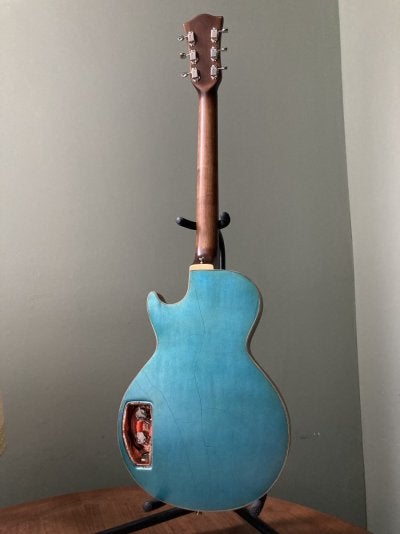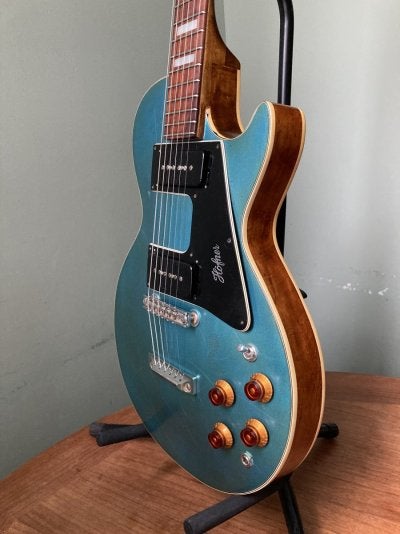Lovato__TN
TDPRI Member
Hello to everyone,
First post on the forum, but also first restoration project.
Several years ago I received as a present this guitar body of what, after what research I could do, concluded it used to be an early 70s Höfner 4579 ii (Höfner's take on Les Paul replicas). The previous owner had stripped off the paint in a rather brutal way, then added some sort of patina, filling up and revealing all the stripping and sanding marks. It was suggested that I restore it as it was, just assembling over that raw finish, which I soon realized I didn't want to keep. Along with the body came a few loose original parts (pickguard, tailpiece, roller bridge, toggle switch). It had been abandoned for several years so I decided it's time to bring it back to life.
This is what it looked like and some quick evolution of what I did, as to not bore you (I used vinegar & steelwool to stain it):





I don't have a spray gun so I had to work with what spray colour I could get my hands on, but the blue isn't quite what I would have wanted it to be. Not too far but not quite there (too bright and not green/gray enough). Now at this point my idea is to use tru-oil on the sides and neck which at the moment are just raw stained wood, just to enhance the wood tone. Over that, I would like to do a nitro lacquer (nitorlack golden age), then eventually work on aging it a bit, achieve some checking and hopefully some yellowing too (maybe with a UV lamp?), make this shiny blue become slightly greener and the binding areas more yellow.
I would mask the fingerboard while doing the nitro. I got monty's montypresso relic wax in order to darken it and I think that should suffice as a finish there.
I still have a few uncertainties;
1) will it be ok to do the nitro finish over the tru-oiled sides of the body? I'm hoping to somehow bring it all together (sides, front, back, binding) with the nitro, so I wouldn't want to mask the sides away. I do think the wood needs some oiling to fire it up, it looks very dry at the moment. I guess the nitro itself would do some of that but I don't think it would be the same as pre-oiled.
2) I would like the back of the neck to remain tru-oil only though (for better playability), should I spray some smooth fade/transition when doing the nitro? would that work? Or better to spray everything and then sand off the neck part?
3) If I would want to darken even further the raw wood parts (besides the fingerboard; sides, neck, headstock); could I apply monty's montypresso relic wax, then tru-oil, then nitro?
4) Any experience with yellowing the nitro with a UV lamp?
I know it all sounds a bit insane, but just exploring options based on my final finish desires; checking what works, what to be aware of, etc.
I've read differing experiences so just putting this out there.
Thanks for reading!
First post on the forum, but also first restoration project.
Several years ago I received as a present this guitar body of what, after what research I could do, concluded it used to be an early 70s Höfner 4579 ii (Höfner's take on Les Paul replicas). The previous owner had stripped off the paint in a rather brutal way, then added some sort of patina, filling up and revealing all the stripping and sanding marks. It was suggested that I restore it as it was, just assembling over that raw finish, which I soon realized I didn't want to keep. Along with the body came a few loose original parts (pickguard, tailpiece, roller bridge, toggle switch). It had been abandoned for several years so I decided it's time to bring it back to life.
This is what it looked like and some quick evolution of what I did, as to not bore you (I used vinegar & steelwool to stain it):
I don't have a spray gun so I had to work with what spray colour I could get my hands on, but the blue isn't quite what I would have wanted it to be. Not too far but not quite there (too bright and not green/gray enough). Now at this point my idea is to use tru-oil on the sides and neck which at the moment are just raw stained wood, just to enhance the wood tone. Over that, I would like to do a nitro lacquer (nitorlack golden age), then eventually work on aging it a bit, achieve some checking and hopefully some yellowing too (maybe with a UV lamp?), make this shiny blue become slightly greener and the binding areas more yellow.
I would mask the fingerboard while doing the nitro. I got monty's montypresso relic wax in order to darken it and I think that should suffice as a finish there.
I still have a few uncertainties;
1) will it be ok to do the nitro finish over the tru-oiled sides of the body? I'm hoping to somehow bring it all together (sides, front, back, binding) with the nitro, so I wouldn't want to mask the sides away. I do think the wood needs some oiling to fire it up, it looks very dry at the moment. I guess the nitro itself would do some of that but I don't think it would be the same as pre-oiled.
2) I would like the back of the neck to remain tru-oil only though (for better playability), should I spray some smooth fade/transition when doing the nitro? would that work? Or better to spray everything and then sand off the neck part?
3) If I would want to darken even further the raw wood parts (besides the fingerboard; sides, neck, headstock); could I apply monty's montypresso relic wax, then tru-oil, then nitro?
4) Any experience with yellowing the nitro with a UV lamp?
I know it all sounds a bit insane, but just exploring options based on my final finish desires; checking what works, what to be aware of, etc.
I've read differing experiences so just putting this out there.
Thanks for reading!



